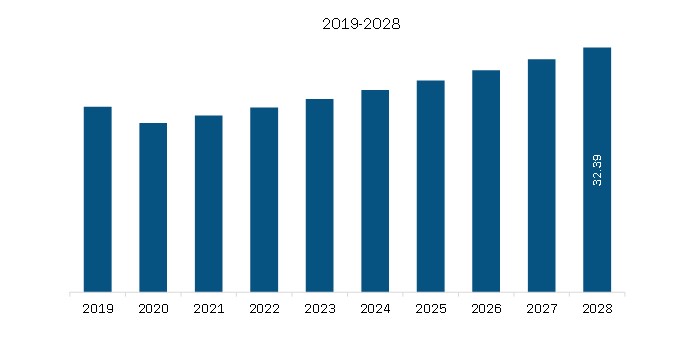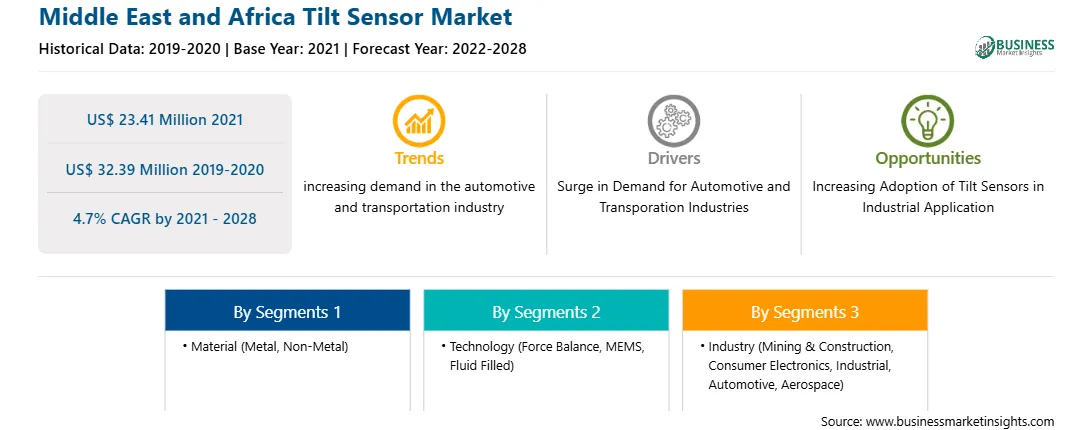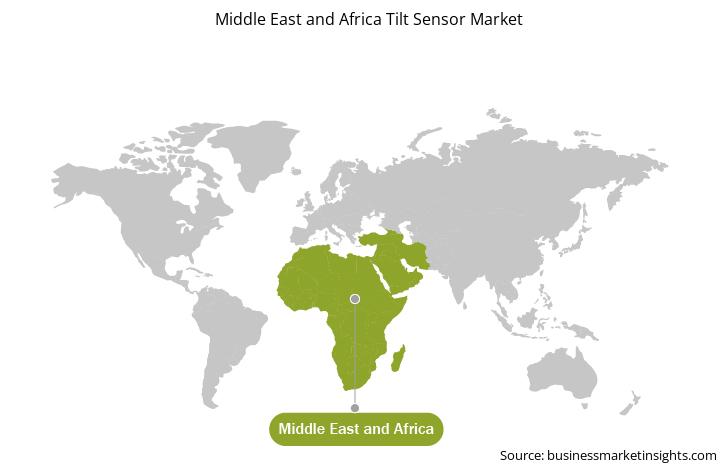Key factors contributing to the market growth are the increasing adoption of tilt sensors in industrial applications and the automotive & transportation sector. However, the high cost of tilt sensors based on force balance technology may hinder the market over the next few years.
The demand for tilt or inclination sensors is growing in the automotive industry. These, together with gyroscopes, are primarily employed to improve passenger safety and vehicle efficiency. Tilt sensors are utilized in various vehicle applications, including electronic parking brakes, rollover detection, electronic stability control, and idle stop-start, among others. Additionally, as automotive firms increase their investments in vehicle automation, the use of ADAS and inertial navigation, hill-start assistance, and dynamic headlight leveling has grown. Mercedes, for example, has created self-leveling lamps that adapt to the road's inclination curves. The organization has installed tilt sensors for this automation as well.
Furthermore, the automobile industry is making progress toward developing self-driving vehicles. In recent years, the development and usage of these cars have increased dramatically. For example, BMW began producing autonomous electric vehicles at their new plant in March 2019. According to UBS, AV production and sales income is predicted to reach USD 243 billion by 2030.
More investments and growth plans in these technologies are projected to continue during the forecast period, which is expected to create demand for tilt sensors in the industry.
The MEA tilt sensor market is majorly affected by the disruption in the supply chain. Pertaining to the closure of borders of countries, the supply chain of several components and parts has been disturbed. The demand for sensor systems and sensors has weakened since the eruption of COVID-19 in MEA countries. This has resulted in a loss of business among sensor systems and sensor manufacturers offering their products to various industries in the region.
Countries with higher manufacturing units, such as Turkey, Israel, and South Africa, have witnessed critical scenarios in procuring various electronics and semiconductor products, including sensors that showcased a fall in the MEA tilt sensor market in the region.
The construction activity in the region is among the rapidly growing industry. The UAE, Saudi Arabia, and Qatar represent the forerunners in the GCC construction industry. The outbreak of the COVID-19 virus had paused several construction activities in the countries mentioned above, and some of the projects are still likely to remain halted. This parameter is among the key factors that have negatively impacted the sensor systems industry and subsequently impaired the tilt sensor market.
The growth of environmental policies, the introduction of new technology, and shifting consumer attitudes surrounding ownership are causing significant changes in the Middle East economy. Almost every industry has been transformed by new business models, increased automation, and digitization, and the automotive industry is no exception. As a result of these causes, a number of disruptive technology-driven trends in the automotive industry have emerged, including autonomous driving, electrification, diversified mobility, and connectivity. Today, the industry is ready for disruption in the Middle East, and most players believe that recent trends will gain traction and reinforce one another. These factors are likely to help the MEA tilt sensor market recover after the pandemic.

Strategic insights for the Middle East and Africa Tilt Sensor provides data-driven analysis of the industry landscape, including current trends, key players, and regional nuances. These insights offer actionable recommendations, enabling readers to differentiate themselves from competitors by identifying untapped segments or developing unique value propositions. Leveraging data analytics, these insights help industry players anticipate the market shifts, whether investors, manufacturers, or other stakeholders. A future-oriented perspective is essential, helping stakeholders anticipate market shifts and position themselves for long-term success in this dynamic region. Ultimately, effective strategic insights empower readers to make informed decisions that drive profitability and achieve their business objectives within the market.

| Report Attribute | Details |
|---|---|
| Market size in 2021 | US$ 23.41 Million |
| Market Size by 2028 | US$ 32.39 Million |
| CAGR (2021 - 2028) | 4.7% |
| Historical Data | 2019-2020 |
| Forecast period | 2022-2028 |
| Segments Covered |
By Material
|
| Regions and Countries Covered | Middle East and Africa
|
| Market leaders and key company profiles |
|
The geographic scope of the Middle East and Africa Tilt Sensor refers to the specific areas in which a business operates and competes. Understanding local distinctions, such as diverse consumer preferences (e.g., demand for specific plug types or battery backup durations), varying economic conditions, and regulatory environments, is crucial for tailoring strategies to specific markets. Businesses can expand their reach by identifying underserved areas or adapting their offerings to meet local demands. A clear market focus allows for more effective resource allocation, targeted marketing campaigns, and better positioning against local competitors, ultimately driving growth in those targeted areas.

The Middle East and Africa Tilt Sensor Market is valued at US$ 23.41 Million in 2021, it is projected to reach US$ 32.39 Million by 2028.
As per our report Middle East and Africa Tilt Sensor Market, the market size is valued at US$ 23.41 Million in 2021, projecting it to reach US$ 32.39 Million by 2028. This translates to a CAGR of approximately 4.7% during the forecast period.
The Middle East and Africa Tilt Sensor Market report typically cover these key segments-
The historic period, base year, and forecast period can vary slightly depending on the specific market research report. However, for the Middle East and Africa Tilt Sensor Market report:
The Middle East and Africa Tilt Sensor Market is populated by several key players, each contributing to its growth and innovation. Some of the major players include:
The Middle East and Africa Tilt Sensor Market report is valuable for diverse stakeholders, including:
Essentially, anyone involved in or considering involvement in the Middle East and Africa Tilt Sensor Market value chain can benefit from the information contained in a comprehensive market report.